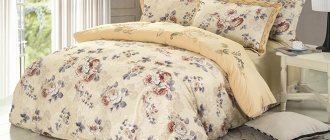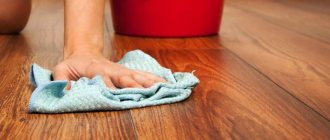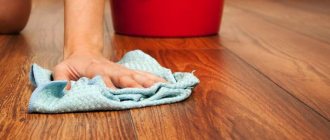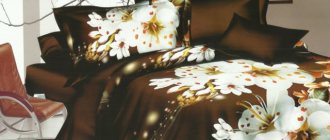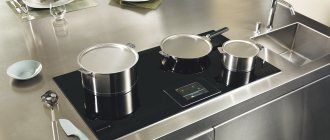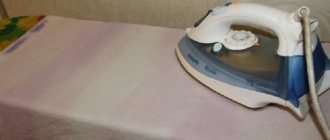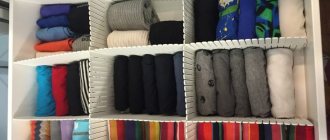Nowadays, the market offers a wide range of fabrics made from natural cotton: satin, calico, chintz and others. The materials are in great demand due to their hygiene, wear resistance and strength. At times it is very difficult to understand this diversity and understand, for example, what is better - percale or poplin.
The difficulty lies in the fact that these fabrics are similar in basic properties, and it is sometimes difficult for the average consumer to understand how they differ from each other.
Which material is better, satin or polysatin?
The main difference from polysatin
lies in the naturalness of ordinary
satin
- it is made from cotton fiber.
The fabric is cool and soft to the touch, like silk, but at the same time retains heat well and “breathes”. satin
bed linen you will not freeze in winter, it will pleasantly refresh you on a hot day.
Interesting materials:
How to prepare a cast iron duck pot? How to prepare a cast iron cauldron? How to prepare a granite frying pan? How to prepare a cast iron cauldron for use? How to prepare a cast iron cauldron for use? How to prepare a cauldron before first use? How to prepare a new cast iron frying pan for use? How to prepare a new cast iron skillet? How to prepare a new frying pan? How to prepare a new cauldron for use?
Poplin - description
The fabric has a plain weave and a relief with a characteristic small rib. The technology was developed in France many centuries ago, and the canvas was intended for the clothes of the Pope. The structure is obtained through the use of threads of different thicknesses. The base is formed from thin fibers that are intertwined with thicker ones.
Poplin has good tactile properties, it is pleasant and soft. It has the density and strength of fabrics for sewing overalls.
Modern textiles are produced:
- bleached;
- variegated;
- printed;
- plain painted.
Poplin is produced in different colors and is used mainly for bed linen. Pajamas, men's shirts, dresses and other everyday clothes are also made from this fabric. The sets are comfortable to use and are durable in shape and color. The positive properties of poplin include the ability to retain heat, absorb moisture and allow air to pass through.
Caring for natural fabrics
Since percale and poplin have similar properties, the principles of caring for products made from these materials are the same.
To keep the fabric in good shape longer, you will need to follow the following rules.
- Before using the bedding set, carefully study the product label, which describes the basic requirements for caring for the material.
- Before washing, keep poplin or percale items in a special basket with holes to provide air access to the fabric.
- Wash items made from natural fibers separately from other items at a water temperature not exceeding 80 degrees.
- Use washing and conditioning products suitable for this type of material.
- Dry items in the fresh air in a vertical or horizontal position. These materials are not afraid of sunlight, the paint does not fade, so you can hang them on the balcony even in clear and hot weather.
- Iron items only on the reverse side with the iron heated to no more than 150 degrees.
- Bed linen made from these fabrics should be stored in a ventilated closet in a dry and warm room.
By following these simple recommendations, you can significantly extend the life of products made from natural fabrics and not have to think about purchasing new bed linen for many years.
What is the difference between satin and cotton?
The difference between satin and cotton
is that the first word denotes the technique of weaving threads, and the second - the origin of the fabric.
Sateen
, in principle, can be called both a synthetic and a silk product, but usually in this case it means cotton fabric. Fabric of this kind is considered exquisite.
Interesting materials:
What needs to be done to develop logic? What should you do to strengthen your bones? What should you do if the screen on your laptop has become larger? What should you do if the kitten does not eat? What should you do if one earphone does not work? What should you do if you choked? What should you do if you have a cold neck? What should you do if the thermometer breaks? What should you do if you get burned? What should you do if you are stung by a jellyfish?
What is better for bed linen
The quality of bed linen has a direct connection with proper rest and healthy sleep. Therefore, the choice of material must be conscious, taking into account the advantages and disadvantages.
It remains to evaluate whether percale or poplin is better and for what conditions.
Both materials are made from cotton raw materials using plain weave technology. The structure resembles a checkerboard pattern, where the warp thread is replaced by weft, overlapping one another. This is the similarity between them.
Now about the differences:
- Percale fibers are much thinner than poplin. In addition, they are carefully combed out and covered with an adhesive composition without twisting. These factors give it maximum strength. It’s not for nothing that the material is used in sewing parachutes and finishing airplane wings.
- If you examine fabric samples against the light, you will find that the structure of poplin is looser, while that of percale is denser. This is explained by the tightness of the mutual fit of the threads during manufacturing. Our grandmothers used percale covers for pillows and featherbeds, knowing the property of the material to reliably retain down and feathers.
Advice!
Manufacturers reserve the right to add synthetic fibers that affect properties. Be sure to look at the label before purchasing.
- Percale is a leader in density and strength, which ensure wear resistance and durability. It has higher quality indicators and a service life of 10 years, while poplin underwear is designed for 5.
- In terms of physical characteristics, both fabrics are thin and light. The poplin is soft to the touch and does not wrinkle. Percale is silky and cool, which is important for summer days. However, it wrinkles and requires ironing after washing.
- Percale has a reverse side, noticeable to the touch and in color saturation, and poplin is a double-sided material. Percale bed linen has a number of other advantages:
- Withstands about 100 washes without loss of properties;
- Perfectly comfortable fabric that warms and cools;
- High density and strength;
- There is no shrinkage after washing and no unsightly pilling.
Several facts in favor of poplin.
- Air permeability and heat-saving properties.
- Resistance to crushing and deformation, which makes the work of housewives easier.
- Smoothness, softness and comfort while sleeping.
- Care is limited to normal washing.
However, the fabrics are not inferior to each other in appearance. They delight with bright colors and beautiful patterns. Both materials are easy to cut and sew, do not slip or warp. With similar qualities, a poplin set will cost less.
Expert opinion
Alyona
Fabric expert and technologist Alena Khlebnikova is ready to answer your questions.
Write me
There is no universal answer to which is better. This is a matter of personal preference and material capabilities.
Interesting fact
European manufacturers have rated percale bed linen sets at the level of satin products.
How to distinguish percale from calico?
Let's start with the fact that both percale and calico are made by simple plain weave of threads.
In the process of making calico, threads of the same thickness are used. The technology for making percale is somewhat different - the front threads are thin, treated with a special adhesive, and the back threads are thick.
You can distinguish calico from percale by touch - percale is smoother, silkier and more delicate. Calico is more loose. External differences are also noticeable to the naked eye - percale is characterized by a beautiful semi-matte shine, while calico looks more simple and prosaic.
The differences between satin and percale are less pronounced - both fabrics have a smooth and silky top layer, while percale is rougher and denser than satin.
Fabrics by density
It is unlikely that buyers think about such quality as density when looking at new items in the store’s assortment. Meanwhile, density is important.
The highest density is terry - from 300 to 800 g/m². Also on the pedestal in terms of strength is microfiber - from 230 to 380 g/m². Slightly inferior to the “palm” are mako-satin (from 220 and above g/m²), jacquard (from 170 to 220 g/m²) and flannel (from 165 to 175 g/m²). In the “middle peasants” in terms of density - bamboo (120 g/m²), linen (125-150 g/m²), percale (100-170 g/m²), poplin (110-120 g/m²), calico (100-140 g/m²). Satin has a density from 85 to 170 g/m². Rounding out the “order” are calico (from 100 to 140 g/m²), silk (80-90 g/m²) and chintz (80-100 g/m²).
Comparing calico with poplin and satin
Calico and poplin are budget options for fabrics for sewing bed linen. They have good strength properties, can withstand a large number of washes, and are easy to care for. At the same time, calico is a denser material than poplin and satin.
As for the cost of fabrics, calico and poplin cost about the same, but satin is an expensive luxury fabric that looks much more presentable and richer.
Sale of bed linen sets
Best prices for bulk purchases
View in the catalog
Comparing percale with poplin and satin
Percale, poplin and satin are cotton fabrics that have similarities and differences. All of them are quite popular and in demand when sewing bed linen.
The main difference between these fabrics is the type of weave of threads (satin weaving for satin, plain weaving using threads of different thicknesses for percale and poplin).
In addition, in the process of weaving satin, highly twisted threads are used, due to which the top layer of the fabric is smooth and slightly shiny.
Percale is superior in strength to both satin and poplin. In addition, this fabric is considered the most wear-resistant fabric of all the above.
The advantages of satin are its impeccable appearance, a large number of color options, a smooth surface to which dust and animal hair do not stick.
Poplin is favored by its low cost, good wear resistance and softness.
Characteristics of two materials
Percale is a dense, smooth, strong cotton material. Along with ranfors, calico and satin, it is often found on bed linen labels. Made from combed, unspun, long-staple cotton. Before spinning, the threads are treated with sizing - a strengthening and adhesive composition made from glycerin, starch, and fats.
Poplin is also a natural cotton fabric. When making it, a special type of weaving is used, with scars. The weft thread is 1.5-2 times thinner than the warp. Braiding thick threads with thin ones gives the fabric additional stability. It is strong, wear-resistant, durable.
Very rarely, both materials may contain synthetic fibers. Despite their density, they are thin, soft, and pleasant to the touch.
Satin is an expensive pleasure
Satin linen is expensive. This is dense, high-quality cotton, its surface is smooth and shiny, visually practically indistinguishable from silk. But such external characteristics can be signs of the addition of elastane to the fibers, so you need to read the labels carefully.
Satin underwear is warmer than silk, does not electrify, practically does not wrinkle, lasts a long time, and is suitable for daily use. The fabric does not lose its performance qualities within 250–300 machine washes. Satin linen should be washed at 40–60 °C.
In the production of satin, long-fiber Egyptian cotton is usually used. The fabric is woven using the satin method, in which the weaving is exclusively double; on the front side, weft threads predominate, forming a diagonal scar. The density of satin is high - 115–130 g/m2. To make the fabric even stronger and hold the pigment better, it is treated with alkaline compounds in high concentrations.
Sometimes you can see underwear, oh. This is the most expensive version of cotton, the fibers of which do not contain the slightest additional inclusions.
When weaving satin, two threads are used: the main thread is thick, simple, and forms the wrong side, and shiny, thin, twisted, forms the front side. Thanks to this, the underside of satin linen turns out to be slightly rough, matte and, unlike silk products, does not slip off the bed.
Linen is made from bleached, plain-dyed, printed, that is, patterned, and jacquard, that is, embossed, satin. The latter is the most expensive, but less practical, wrinkles quickly, and requires ironing while wet from the inside out.
Pros of satin lingerie:
- does not make the body sweat in the heat, keeps warm on cool nights;
- absorbs moisture, allows air to pass through;
- looks attractive;
- has a long service life;
- is durable;
- does not fade;
- meets hygienic standards and ensures comfort during sleep.
Minuses:
- it costs expensive;
- requires care;
- not recommended as winter underwear.
Basic criteria for choosing fabric
What criteria do you consider priority when choosing bed linen? What do you lean towards - spectacular appearance or daily comfort, price or quality?
We spend a third of our lives sleeping, so choosing the right bedding is fundamentally important.
Naturalness and quality
All types of fabric discussed above, namely calico, satin, poplin and percale, are natural cotton environmentally friendly materials. They have valuable qualities: they allow air to pass through, absorb moisture, relieve static tension, do not provoke the proliferation of pathogenic bacteria, and do not cause allergies. The natural properties of cotton provide the necessary comfort and hygiene of linen, which makes it a safe and versatile solution for everyday use.
Before buying a ready-made set or fabric for sewing bed linen, be sure to read the label indicating the composition of the fabric
Which fabric is best for bed linen? Natural, of course. Although small admixtures of artificial materials even bring some benefits: they increase wear resistance, reduce creasing, and provide elasticity. But if the composition contains more than 75% synthetics, the fabric stops allowing air to pass through, creating a “greenhouse effect” in the bed and accumulating static electricity.
Now many manufacturers are reducing the cost of traditionally natural fabrics by adding synthetic fibers: polyester, nylon, viscose, microfiber, spandex, etc.
Care
According to this indicator, the best choice is poplin or satin, which wash well at low temperatures (30-40 ℃) and do not require careful ironing.
Ironing provides additional disinfection of bed linen
Calico and percale must be ironed to give these fabrics softness and smoothness. It is recommended to wash calico without bright printed patterns at a temperature of 40-60 ℃ and iron it with a hot iron before it has had time to dry completely.
Appearance and price
Satin and percale are considered the most aesthetic and “rich”, as they have a smooth surface texture with a noble shine. This directly affects their price, which can significantly exceed the cost of similar-sized calico sets. In terms of the ratio of appearance and cost of fabric, poplin is the optimal choice for many.
In any case, it is up to you to decide which fabric is best for bed linen. We hope that our article will help you make your choice.

